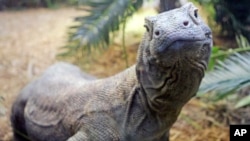Komodo dragons, fearsome giant lizards found in Indonesia, may be a source of a potent antibiotic. If so, researchers say the agent could be an answer to the growing, global health problem of antibiotic resistance.
Huge, toothy and aggressive, Komodo dragons are surrounded by filth in their daily lives. As a result, Barney Bishop, a biochemist at George Mason University near Washington, said Komodo dragons have developed what he called a "robust" immune system.
Bishop studies molecules produced by the immune system as a front-line defense against infection. That, he said, is the reason for the interest in Komodos.
"They are known to eat carrion; they live in an unsanitary environment; they have been recorded to have up to 57 bacterial strains in their mouths," some of which can cause disease, he said. "Yet the reptiles themselves are not harmed by these bacteria, whether it's in their mouths or wounds inflicted by other lizards."
Bishop and his colleagues, working with blood from Komodos, isolated peptides, or small proteins, produced by the reptiles' immune systems. The peptides, Bishop said, seem to have remarkable anti-bacterial properties.
Artificial version tested
Researchers made artificial versions of these peptides and tested the most promising one — DRGN-1, or DRAGON-1 — in wounded mice and human skin cell cultures. They found the protein molecules exhibited three outstanding properties: They destroyed the outer layer of bacteria, dissolved biofilms — a sticky colony that microbes form to shield against antibiotics — and speeded up healing.
The work with Komodo dragon peptides was published in the journal Biofilms and Microbiomes.
Bishop said, "Their peptides may offer some promise and some new insights or provide new templates for development of new therapeutics to treat infection."
Bishop said the three-pronged action of DRGN-1, if made into an antibiotic, would make it unlikely that disease-causing bacteria could become drug-resistant.
The Defense Threat Reduction Agency, an agency of the U.S. Defense Department, paid for the research. The military is interested in the work because it may relate to bioweapons.
Samples of blood for the study were taken from a 45.3-kilogram (100-pound) male Komodo dragon named Tujah who lives at the St. Augustine Alligator Farm and Zoological Park in Florida.
Bishop said only a one-time sample of blood was needed because the peptides were artificially reproduced, so no animal was harmed for the study.






